The hanging terrarium is a modern take on an old classic.
A versatile way to fill vertical space in your home or a creative way to create a botanical wedding centerpiece.
But let’s be honest, it’s mostly just a way to get more plants when you’ve run out of surfaces, isn’t it?
In this guide, I will take you through everything you need to know about hanging terrariums. What kind of plants and projects are suitable, and how you might go about building one.
Hang on tight; here we go!

Terrarium Tribe is reader-supported. When you purchase through links on our site, we may earn an affiliate commission (at no further cost to you). 💜
Hanging Terrarium DIY – Key Considerations
Okay, so hanging a terrarium with plants definitely requires some out-of-the-box thinking.
Of course, there are the logistical necessities involved in mounting a terrarium on a rope (I hope you’ve brought your DIY hat!), but the process also influences what you do in your build.
You might want to rethink the delicately stacked slate staircase, for example…
Instead, consider these three principles.
- Simple – Let’s face it, hanging terrariums aren’t the best place to get experimental with complex designs and features (especially if they’re going to end up as gifts or wedding decorations). There’s a lot more that can go wrong here. The simpler, the better.
- Secure – Being secured to the rope is clearly important, but can you construct your landscape in such a way that it holds together, even if swung around a little? This probably means more creative use of hardscape and minimal loose substrate. More on that later.
- Central – You’ll need to design your terrarium in such a way that its center of gravity is, well… central. Otherwise, it’s going to hang crooked and risk spilling out all of your beautiful additions onto the floor.
Honestly, there are no hard-and-fast rules here. But if this is your first attempt at a hanging terrarium DIY project, these should keep you on the right path.
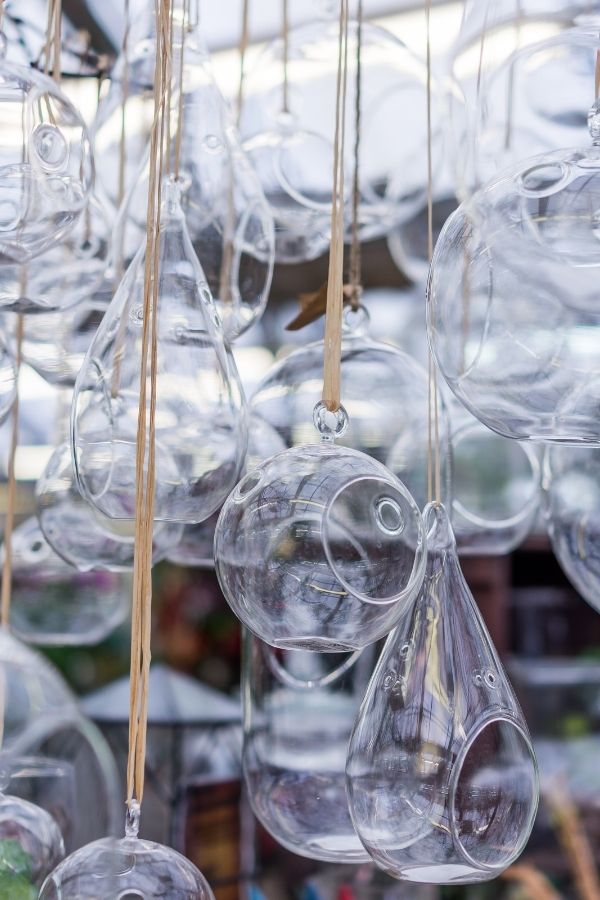
Hanging Glass Terrarium vs Plastic Terrarium
A hanging glass terrarium can require some extra care and attention, both in the planning and execution.
It’s arguably more aesthetic and premium feeling than plastic, and overall I much prefer to work with glass. Though, it is a lot more delicate…
Sure, there’s also the fact that glass is heavier than plastic. Still, if you’re mounting your terrarium properly (please research this before picking up the drill!), that minimal added weight level probably won’t factor in too much.
It’s the bottom of your glass terrarium that’s more likely to fall out than your ceiling.
So, if you’re keen to use glass, then those three considerations above become much more critical. A sudden slip of heavy rock is all it takes to crack the glass and spell disaster.
On the other hand, plastic hanging terrariums are much cheaper and pretty much unbreakable. So you can afford to take more risks (both literally and figuratively).
All that said, let’s get on to the ideas!
5 Cool (and Practical) Hanging Terrarium Ideas
Each of these hanging terrarium ideas utilizes a different type of plant or style of planting.
So, there’s a tonne of versatility within each one (and the decorative part is entirely up to you). Use these as a base and make these your own!
1. Air Plant Terrarium
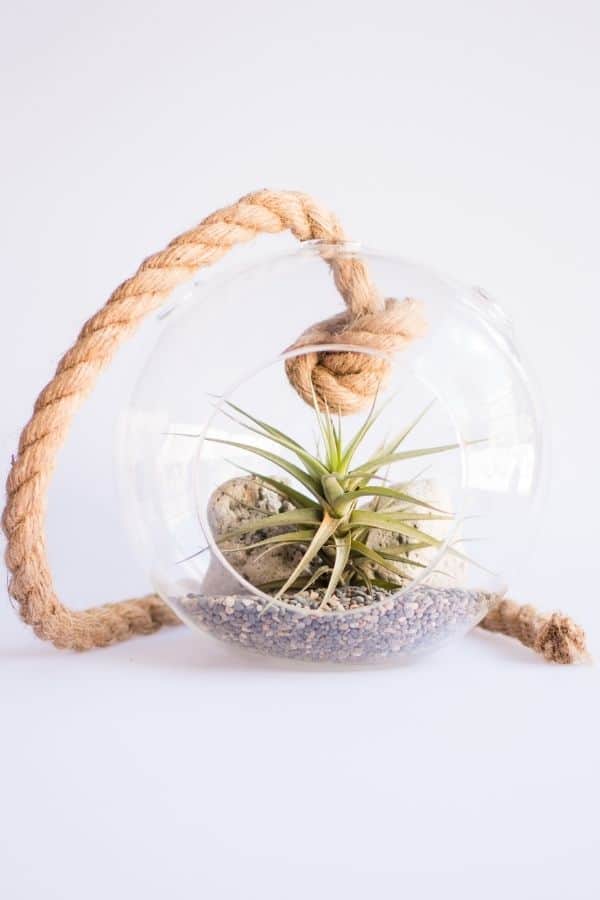
The easiest of all the hanging terrariums has got to be air plant terrariums.
Honestly, air plants are very much a one-and-done situation.
They absorb their water entirely through the air, meaning they don’t need any support in the terrarium besides a container to sit in. Easy right?
That’s not to say you can’t add some sort of substrate base in there (e.g., sand) to make it look like a true terrarium, even if it’s not strictly necessary. It’ll help to keep everything in place.
For your design, you still have endless options available to you.
Mounting air plants in gnarling driftwood branches or nestling them between the likes of crystals or shells works well. Or, you can use Deer Moss (or preserved tropical moss) to add the illusion of live plants without the extra care.
Start with plants from the Tillandsia genus, as they tend to be the easiest to manage.
2. Succulent Terrarium
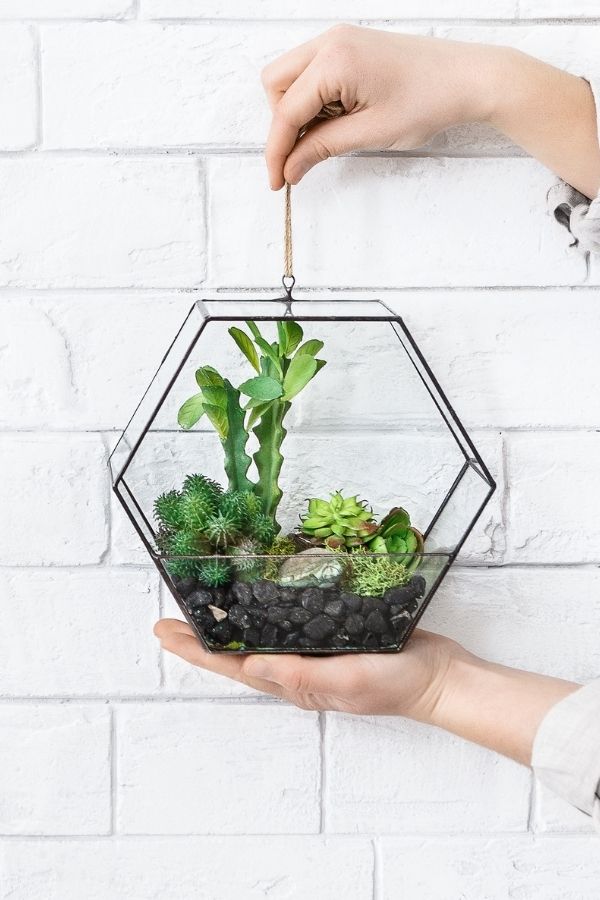
Succulents are next up on the easy list.
With no need for high humidity numbers or consistent moisture, succulents and cacti make for super straightforward plants to keep.
The only real caveat here is that you must provide ample drainage. These arid plant species will quickly rot in soggy conditions, so adding a suitable substrate (and ideally a false bottom) is essential in keeping them healthy and happy.
Thankfully, it’s quite helpful that succulents prefer to be planted in a much grittier substrate (e.g., lava rock) that can hold tightly together in the container versus a loose tropical substrate.
Just like air plants, succulents can be easily dressed up in a wide variety of ways.
Perhaps a rocky beach terrarium?
3. Vine Terrarium
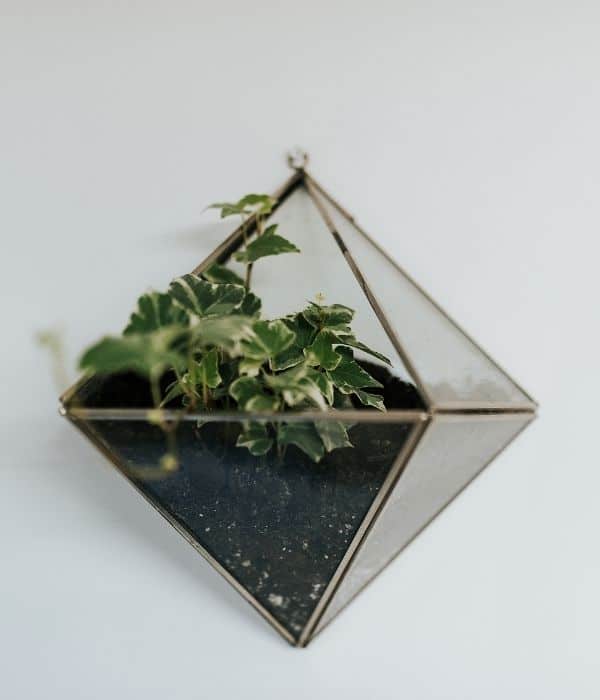
How about using the hanging nature of the terrarium to our advantage?
Using an open hanging terrarium again, we can allow lovely tropical vines to cascade over the edge and dangle down into the air.
I’m talking about the likes of Pothos or Philodendron. These large vines are often too big to fit into closed terrariums, but that’s not an issue here.
The longer they get, the more dramatic the effect.
Both of these plant types are pretty bulletproof overall, so they’ll manage being planted in a less-than-ideal environment. And they’re very forgiving on the watering front.
Other suitable species to consider are Dischidia, Tradescantia, and some vining types of Monstera.
4. Moss Terrarium
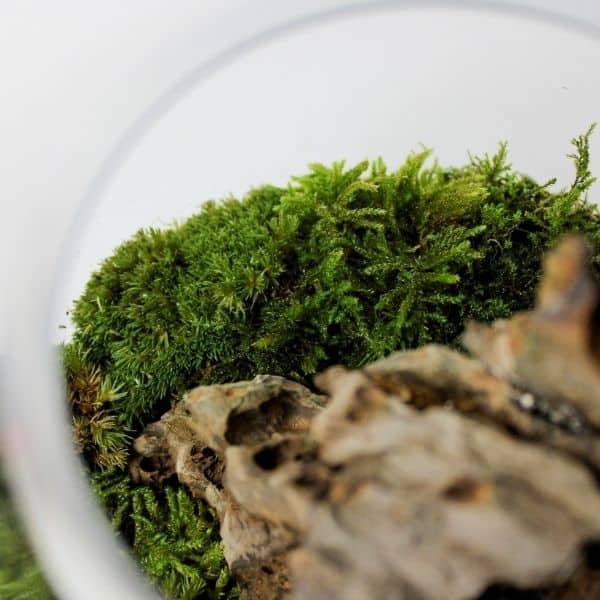
On to the closed hanging terrariums.
As long as you have humidity, moss can grow just fine – so a moss terrarium can be a straightforward and elegant solution.
One of the main advantages of moss is that it doesn’t have roots, so it can easily handle being jumbled around a bit (and it doesn’t even have to be attached to anything to thrive).
I’d recommend a “clumpy moss” like Cushion Moss (Leucobryum glaucum) as it’s full of shape and texture, and you can easily wedge a few strategic clumps in place.
You can still add small rocks and driftwood branches to create a more natural-looking hillside scene.
Alternatively, I’m sure a marimo moss terrarium in water would be pretty straightforward, too!
5. Wabi-Kusa
So, this one’s a bit different…
A Wabi-Kusa is essentially a ball of substrate with lots of tropical epiphytes (usually moss and semi-aquatic species) attached to the outside.
The result is stunning! Like a living green ball.
These are often kept in terrariums, as the epiphytes need high humidity to thrive. So again, closed containers are best for this one.
Not the easiest project to pull off, but a fun one to try.
The best way for a hanging terrarium would be to mount the substrate ball on a central spike of sorts. That way, it can be secured in the center of the container.
Where to Find Hanging Terrariums for Sale
Hanging terrariums come in a variety of shapes and sizes.
For the air plant, succulent, and houseplant terrariums, you’ll want a sturdy hanging container with a large opening (ideally in the front for easy access).
Etsy is full of these!
These can range from teardrops to globes and geometric to diamond prisms. There really is something for everyone.
The moss and Wabi-Kusa terrarium ideas will need either a door or a secure lid for your container. This one would work well with its hinged door, or you can fashion your own cover for one of the above containers.
These days, there are all kinds of great hanging terrarium kits which have everything you need in one go.
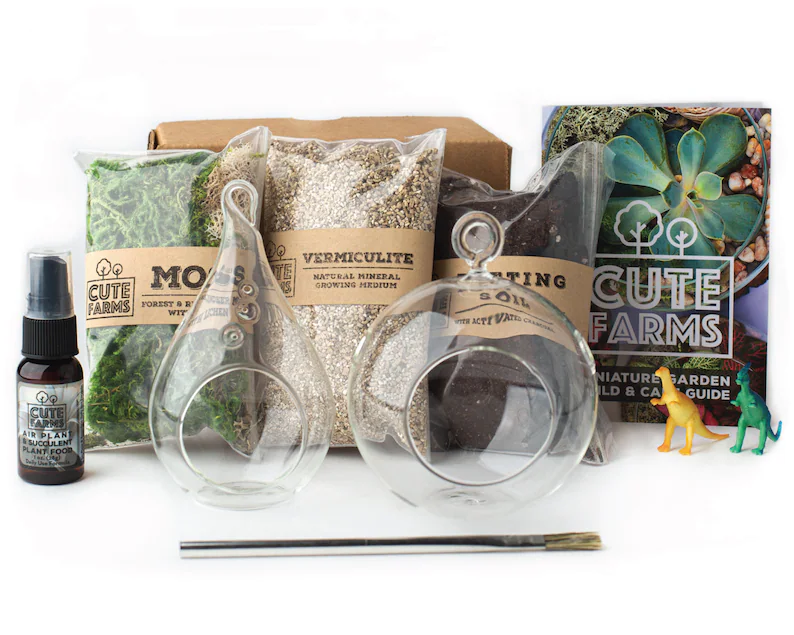
How to Hang a Terrarium
Now that you’ve got your wonderful hanging terrarium creation, you’ve got to figure out how best to hang it in your home.
Sadly, I’m no DIY expert, and I can’t tell you how to put hooks in your home safely. But there are plenty of videos on YouTube that can direct you better (like this one by Harli G, that I’ve learned a variety of other hanging solutions from too).
- Ceiling mounts – This seems to be the most common option, and it really gives the full hanging terrarium experience. It’s great to have such freedom of placement, but it also takes a little DIY knowledge (and, seemingly, you’re restricted to where the joists are).
- Wall brackets – Perhaps slightly less daunting than the ceiling options, mounting a sturdy wall bracket opens up lots of creative planting opportunities around the edges of the room.
- Door hangers – For people who are scared of drilling into buildings, I hear you. Those frames that slot over doors (usually to hang coats) can work for terrariums. Probably best on a door that you don’t open much, though… I imagine any hastily opened doors would crack a terrarium like an egg.
- Curtain rails – Using what’s potentially in your home, if you’ve got some sturdy curtain rails, then you’ve got a couple of potential hanging spots per window already. Clothing rails and canopy beds can work, too – any sturdy rail is a go!
- Stands – Lots of the DIY hanging terrarium kits come with a base and an arm/rod to suspend the terrarium from. It’s a new take on the classic desktop terrarium, I suppose.
Ideally, your container of choice will have some sort of secure hooking system in place. Look out for those with hooks or loops for rope.
If not, you can always get a nice macrame hanger whipped up for you!
Where Do You Hang a Terrarium?
Where to hang a terrarium depends almost entirely on the kind of plants you’ve chosen to put in it.
Succulents and cacti will require lots of full sun and should be hung near a window that gets lots of light throughout the day.
Whereas tropical plants and mosses will be best in a bright spot, out of direct sunlight. Unfortunately, their delicate foliage will quickly suffer in harsh sunlight. Air plants are the same, as they’ll dry out too quickly.
Try hanging them a few feet away from a light source or near a North-facing window (which gets only indirect light) for these kinds of plant terrariums.
Over to You
There you have it!
Five different hanging terrarium ideas and how to pull them off.
Which do you think you’re going to try? Let me know in the comments!
How about a wall terrarium next?
